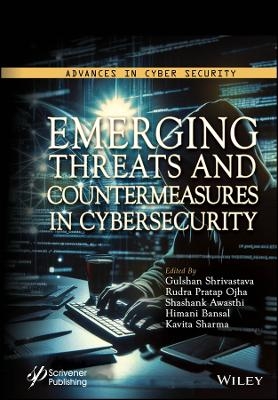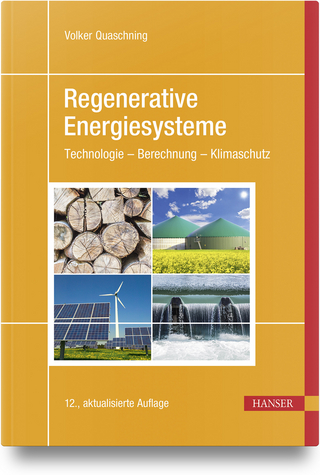
Emerging Threats and Countermeasures in Cybersecurity
Wiley-Scrivener (Verlag)
978-1-394-23057-0 (ISBN)
In the rapidly evolving domain of digital security, this book emerges as a vital guide for understanding and addressing the sophisticated landscape of cyber threats. This in-depth volume, featuring contributions from renowned experts, provides a thorough examination of the current state and future challenges in digital security and forensic analysis. The book is meticulously organized into seven sections (excluding conclusion), each focusing on a critical aspect of cybersecurity. It begins with a comprehensive overview of the latest trends and threats in the field, setting the stage for deeper explorations in subsequent sections. Readers will gain insights into a range of topics, from the intricacies of advanced persistent threats and malware, to the security nuances of cyber-physical systems and the Internet of Things (IoT).
The book covers cutting-edge topics like blockchain, cryptography, social engineering, cloud security, and data privacy, blending theory with practical case studies. It’s a practical guide for cybersecurity professionals, forensic investigators, legal practitioners, law enforcement, scholars, and students. Offering a comprehensive toolkit for combating digital threats, it’s essential for staying ahead in the fast-evolving field of cybersecurity.
Gulshan Shrivastava, PhD, is an associate professor at the School of Computer Science Engineering and Technology at Bennett University, India. He has published five patents and over 55 articles, books, and editorials in international journals and conferences of high repute. He is a life member of the International Society for Technology in Education, senior member of the Institute of Electrical and Electronics Engineers, and professional member of many professional bodies. Rudra Pratap Ojha, PhD, is a professor in the Department of Computer Science and Engineering, G. L. Bajaj Institute of Technology and Management, India. He has published more than 15 papers in national and international journals and conferences. He also works as an editor in various reputed journals and has delivered expert talks and guest lectures at various prestigious institutes. Additionally, he is a life member of the Computer Society of India. Shashank Awasthi, PhD, is a professor in the Department of Computer Science and Engineering, G.L. Bajaj Institute of Technology and Management, India. He has more than 18 years of teaching and research experience across eight countries and has presented his research at various international conferences. He has published more than a dozen research papers in national and international journals of repute. He is a lifetime member of the Institute of Electrical and Electronics Engineers and International Association of Engineers, Hong Kong. Himani Bansal, PhD, is an assistant professor at the Jaypee Institute of Information Technology, Noida, India with over 14 years of experience in academia and the corporate sector. She has published many research papers in various international journals and conferences, as well as chapters and books in several international book series. Additionally, she has served as an editor for several journals and has organized, coordinated, and attended numerous trainings, seminars, and workshops. Kavita Sharma, PhD, is a professor in the Department of Computer Science and Engineering at the Galgotias College of Engineering & Technology, India. She has also been awarded a research fellowship from the Ministry of Electronics and Information Technology from the Government of India. She has more than 12 years of experience in academia and research. She has four patents and has published seven books and 45 research articles in international journals and conferences of high repute and has served as a guest editor, editorial board member, and member of an international advisory board. Additionally, she has actively participated and organized several international conferences, faculty development programs, and various national and international workshops and is a member of numerous professional organizations.
Preface xxv
1 Emerging Threats and Trends in Digital Forensics and Cybersecurity 1
Sethu Laksmi S., Lekshmi Das, Razil S.R. Khan and Pooja Chakraborty
1.1 Introduction 1
1.2 Threats Faced by Digital Forensics 2
1.3 Cybersecurity Threats in 2023 3
1.4 New Era of Technology and Their Risks 6
1.5 Challenges for Digital Forensics 7
1.6 Impact of Mobile Gadgets on Cybersecurity 8
1.7 The Vulnerabilities in Wireless Mobile Data Exchange 8
1.8 Network Segmentation and its Applications 9
1.9 Relationship Between Privacy and Security 10
1.10 Recent Trends in Digital Forensics 10
1.11 Opportunities in this Field 12
1.12 Future Enhancements in Digital Forensics 14
1.13 Cybersecurity and Cyber Forensics in Smart Cities 14
1.14 Network Security and Forensics 16
1.15 Software and Social Engineering Attacks on RSA 17
1.16 Cyber Threats and Cybersecurity 18
1.17 Conclusion 20
Bibliography 20
2 Toward Reliable Image Forensics: Deep Learning-Based Forgery Detection 23
Choudhary Shyam Prakash, Sahani Pooja Jaiprakash and Naween Kumar
2.1 Introduction 23
2.2 Fundamentals of Image Forensics 25
2.3 Deep Learning in Image Forensics 27
2.4 Datasets of Image Forgery Detection 31
2.5 Feature Extraction and Representation 32
2.6 Model Training and Evaluation 32
2.7 Challenges and Future Scope 35
2.8 Conclusion 36
References 36
3 Understanding and Mitigating Advanced Persistent Threats in a Dynamic Cyber Landscape 39
Shami Sushant and Shipra Rohatgi
3.1 Introduction 39
3.2 APT Lifecycle 42
3.3 Characteristics and Methods of APTs 43
3.4 APT Detection 46
3.5 Mitigation Techniques 51
3.6 Case Study: CozyDuke APT 56
Conclusion 58
References 58
4 Class-Imbalanced Problems in Malware Analysis and Detection in Classification Algorithms 61
Bidyapati Thiyam, Chadalavada Suptha Saranya and Shouvik Dey
4.1 Introduction 61
4.2 Background 62
4.3 Related Work 64
4.4 Detailed Overview of the Methodology 72
4.5 Discussion and Challenges 76
4.6 Conclusion 77
References 77
5 Malware Analysis and Detection: New Approaches and Techniques 83
Laiba Mazhar and Shipra Rohatgi
5.1 Introduction 83
5.2 Malware 84
5.3 Case Studies 99
5.4 Future Aspects 102
5.5 Conclusion 107
References 108
6 State-of-the-Art in Ransomware Analysis and Detection 111
Amit Kumar Upadhyay, Preeti Dubey, Sahil Gandhi and Shreya Jain
6.1 Introduction 111
Evolution 113
Lifecycle 116
Infection Method 118
Targets of Ransomware Attacks 120
Payment Process and Method 121
Ransomware Analysis 122
Ransomware Detection 123
Ransomware Prevention 126
Recovery 128
Characteristics 130
Difficulties 131
Impact of Ransomware Attacks 132
Statistics 134
Conclusion 134
References 134
7 Cyber-Physical System Security: Challenges and Countermeasures 137
Ankit Garg, Anuj Kumar Singh, Aleem Ali and Madan Lal Saini
7.1 Introduction 137
7.2 Challenges in CPS Security 141
7.3 Security Risks and Consequences 145
7.4 Key Considerations for CPS Security 147
7.5 Countermeasures for CPS Security 150
7.6 Case Studies and Examples 153
7.7 Future Directions and Emerging Technologies 155
7.8 Conclusion 156
References 157
8 Unraveling the Ethical Conundrum: Privacy Challenges in the Realm of Digital Forensics 161
Tushar Krishnamani and Parmila Dhiman
8.1 Introduction 161
8.2 Fundamental Concepts in Digital Forensics 162
8.3 Privacy Concerns in AI Technology: Security Systems and Cyber Forensics 163
8.4 Maintaining Integrity of Evidence in Forensic Investigations 165
8.5 Ethical Obligations of Forensic Investigators 166
8.6 Conclusion 171
References 171
9 IoT and Smart Device Security: Emerging Threats and Countermeasures 173
Akhilesh Kumar Singh, Ajeet Kumar Sharma, Surabhi Kesarwani, Pradeep Kumar Singh, Pawan Kumar Verma and Seshathiri Dhanasekaran
9.1 Introduction 173
9.2 The Growth of IoT and Smart Devices 174
9.3 Emerging Threat Landscape 175
9.4 Device Vulnerabilities and Exploits 176
9.5 Data Privacy and Leakage 177
9.6 Network Attacks and Amplification 178
9.7 Physical Attacks on Smart Devices 183
9.8 Supply Chain Risks in IoT Ecosystem 184
9.9 Lack of Standardization in IoT Security 185
9.10 Countermeasures and Best Practices 187
9.11 Conclusion and Future Directions 188
References 188
10 Advanced Security for IoT and Smart Devices: Addressing Modern Threats and Solutions 191
Himanshu Sharma, Prabhat Kumar and Kavita Sharma
10.1 Introduction 192
10.2 IoT and Smart Device Landscape 193
10.3 Emerging Threats in IoT and Smart Device Security 196
10.4 Vulnerabilities in IoT and Smart Devices 199
10.5 Countermeasures and Best Practices 201
10.6 Security Standards and Regulations 204
10.7 Security Testing and Assessment 206
10.8 Incident Response and Recovery 207
10.9 Case Studies: Real-World Examples 209
10.10 Future Trends and Challenges 211
10.11 Conclusion 213
References 215
11 Threats and Countermeasures for IoT and Smart Devices 217
Amrit Suman, Preetam Suman, Sasmita Padhy, Roshan Jahan and Naween Kumar
11.1 Introduction 217
11.2 IoT Architecture 219
11.3 Security in the Application Layer of IoT 221
11.4 Literature Survey 227
11.5 Results and Discussion 232
11.6 Conclusion and Future Work 234
References 235
12 Insider Threat Detection and Prevention: New Approaches and Tools 241
Rakhi S., Sampada H. K., Arun Balodi, Shobha P. C. and Roshan Kumar
12.1 Introduction 241
12.2 Insider Attack: A Big Picture 246
12.3 Tools and Technology for Insider Threat Detection 249
12.4 Results and Discussions 258
12.5 Conclusion 261
References 261
13 A Holistic Framework for Insider Threat Detection and Analysis Upon Security and Privacy for Data Management Services 263
A. Sheik Abdullah, Hanish Shyam, Sriram B., Arif Ansari and Subramanian Selvakumar
13.1 Introduction 263
13.2 Defining Insider Threats 270
13.3 Know Your Critical Assets in Data Management Services 276
13.4 Insider Risk Management 282
13.5 Diving Deeper Into Holistic Framework 287
13.6 Conclusion 299
References 299
14 Revolutionizing SEO: Exploring the Synergy of Blockchain Technology and Search Ecosystems 303
Bharti Aggarwal, Dinesh Rai and Naresh Kumar
14.1 Introduction 303
14.2 Features of Blockchain 305
14.3 Literature Review 306
14.4 Integrating Blockchain into Search Ecosystems for Enhancing SEO 309
14.5 Integration of Blockchain in Search Ecosystems 310
14.6 Concept of Decentralized Search Platforms and Role in SEO Improvement 311
14.7 Use Cases and Projects Illustrating Blockchain Integration in Search Ecosystems 312
14.8 Future Trends and Implications 315
14.9 Potential Implications for the SEO Industry and Online Marketing Strategies 316
14.10 Conclusion 318
References 318
15 Emerging Trends and Future Directions of Blockchain Technology in Education 325
Urvashi Sugandh, Priyanka Gaba, Arvind Panwar and Jyoti Agarwal
15.1 Introduction 325
15.2 Overview of Blockchain Technology in Education 328
15.3 Emerging Trends in Blockchain and Education 330
15.4 Implications for the Future of Education 335
15.5 Future Directions for Blockchain in Education 340
15.6 Conclusion 345
References 346
16 Social Engineering Attacks: Detection and Prevention 349
Manpreet Kaur Aiden, Sonia Chhabra, Shweta Mayor Sabharwal and Alaa Ali Hameed
16.1 Introduction 349
16.2 Phases of Social Engineering 351
16.3 Methods of Social Engineering 352
16.4 Insider Threat 362
16.5 Impersonation on Social Media Platforms 366
16.6 Identity Theft 367
16.7 Social Engineering Detection and Prevention 371
16.8 Conclusion and Future Directions 379
References 381
17 Social Engineering Attacks in Industrial Internet of Things and Smart Industry: Detection and Prevention 389
Muhammad Muzamil Aslam, Kassim Kalinaki, Ali Tufail, Abdul Ghani Haji Naim, Madiha Zahir Khan and Sajid Ali
17.1 Introduction 390
17.2 Phases of Social Engineering Attacks 391
17.3 Social Engineering Attacks in IoT and IIoT 392
17.4 Techniques of Social Engineering Attacks 393
17.5 Social Engineering Attack Vectors 399
17.6 Social Engineering Attack Detection and Prevention Techniques 403
17.7 Real-World Social Engineering Attacks in the Industry 404
17.8 Challenges and Future Prospective in Social Engineering Attacks 406
17.9 Future Prospective and Recommendations 406
17.10 Conclusion 407
References 407
18 Cloud Security Essentials: A Detailed Exploration 413
Abhishek Singh Vardia, Aarti Chaudhary, Shikha Agarwal, Anil Kumar Sagar and Gulshan Shrivastava
18.1 Introduction 413
18.2 The Importance of Cloud Security 414
18.3 Key Cloud Security Concerns 415
18.4 Cloud Security Challenges 422
18.5 Cloud Security Challenges and Strategies 425
18.6 Common Threats in Cloud Security 426
18.7 Best Practices for Cloud Security 427
18.8 Conclusion 430
References 431
19 Data Privacy and Protection: Legal and Ethical Challenges 433
Oladri Renuka, Niranchana RadhaKrishnan, Bodapatla Sindhu Priya, Avula Jhansy and Soundarajan Ezekiel
19.1 Introduction 433
19.2 Fundamental Concepts of Data Privacy and Protection 435
19.3 Legal Frameworks for Data Privacy and Protection: Overview of Global Data Protection Laws 437
19.4 Rights and Principles Underpinning Data Privacy 440
19.5 Challenges in Implementing Data Privacy Regulations 442
19.6 Ethical Considerations in Data Collection and Usage: Transparency and Informed Consent 446
19.7 Emerging Technologies and Ethical Dilemmas: Impact of AI, IoT, and Biometrics on Data Privacy 449
19.8 Legal and Ethical Reactions to Data Breach and Privacy Incidents: Legal Requirements for Notifying Data Breach 452
19.9 Surveillance, National Security, and Individual Privacy: Striking a Balance: Privacy vs. National Security 454
19.10 Regulatory Enforcement and Accountability: Role of Data Protection Authorities 456
19.11 Future Trends and Considerations: Evolving Legal Landscapes and Global Harmonization 459
19.12 Conclusion: Navigating the Nexus of Data Privacy and Protection 462
Conclusion 463
References 463
20 Future Direction in Digital Forensics and Cyber Security 467
Ar. Varsha, Nayana Anoop Kumar, Sosthenes Nyabuto Bichanga and Pooja Chakraborty
20.1 Introduction 467
20.2 Evolution of Crime 468
20.3 Existing Cybercrime Rate in India and World 468
20.4 Emerging Cybercrime and its Future 472
20.5 Recent Paradigm Shift in Cyber Menace 480
20.6 Cyber Security 484
20.7 Artificial Intelligence 485
20.8 Contemporary Condition of Digital Forensics 488
20.9 Challenges of Digital Forensics 489
20.10 Legal Aspect of Cyber Laws 489
20.11 Prevention Against Cybercrimes 491
20.12 Conclusion 492
References 492
Index 495
| Erscheinungsdatum | 07.12.2024 |
|---|---|
| Reihe/Serie | Advances in Antenna, Microwave, and Communication Engineering |
| Sprache | englisch |
| Themenwelt | Technik ► Elektrotechnik / Energietechnik |
| ISBN-10 | 1-394-23057-5 / 1394230575 |
| ISBN-13 | 978-1-394-23057-0 / 9781394230570 |
| Zustand | Neuware |
| Informationen gemäß Produktsicherheitsverordnung (GPSR) | |
| Haben Sie eine Frage zum Produkt? |
aus dem Bereich


